 Add Concrete Wall Opening ( Modeling )
Add Concrete Wall Opening ( Modeling )
Tool summary :
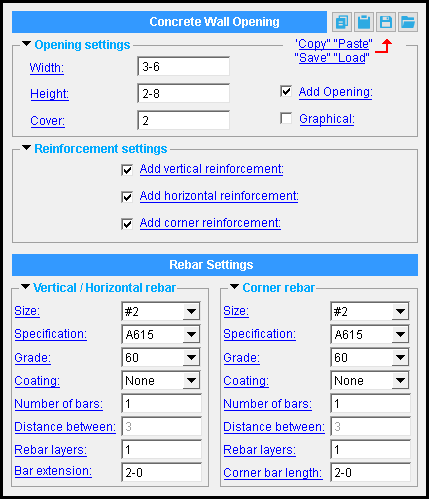
On the Concrete Wall Edit or Cast Elevation Wall Edit window, the name of the leaf for the concrete wall opening " Component " will be " Concrete Wall Opening. "
You can edit the tabs using the settings under that leaf. Or, to open up this window (shown at left), double-click a Concrete Wall Opening material while the " Selection filter " is set to ' Custom Components ''.

Also see :
|
- Modeling (where custom components can be added)
- Custom components (topic)
- Copy Component (to copy a concrete wall opening custom component to another concrete wall or layout)
- Move Component (to move a concrete wall opening custom component to another concrete wall or layout)
- Explode Component (to reduce the custom component to its constituent materials)
- Component Selection Tool (to search for custom components of a selected type)
- Model Tree (to find custom components and select them for deletion, editing, etc.)
- Void Space Layout (an alternative to Concrete Wall Opening)
- CMU Opening (a component for adding openings to CMU walls )
concrete | model > component > | add component | top
 To add, edit or delete the Concrete Wall Opening custom component :
To add, edit or delete the Concrete Wall Opening custom component :
To add the custom component: 1 ) In Modeling , use Snap to Surface or a related tool to go to a plane that is parallel with a side of the wall. 2 ) Place construction lines so that there are INCL points at the locations of the top corners of the opening that you will place. 3 ) Select the wall or layout, so the material changes to the " Primary selection color ." 4 ) Choose Model > Component > Add . 5 ) On the custom component selection list, choose " Concrete Wall Opening " as the custom component you want to add. 6 ) Select the intersections that you defined in step 2. 7 ) The Concrete Wall Opening window opens. Enter the settings that you want, then press " OK " to close the window. 8 ) If User and Site Options > Modeling > " Automatically process after modeling operation " is set to ' Process and create solids ', the opening and its reinforcement will be generated immediately. If not, they will be generated on the wall the next time the wall undergoes Process and Create Solids .
Tip: If you use in-tool selection -- that is, select the wall after selecting " Concrete Wall Opening " as the custom component you want to add -- only concrete walls and concrete elevations wall layouts will be selectable. To edit a Concrete Wall Opening component or review its settings, you can find the wall or layout it is added to and open its edit window. The component's settings will be contained in that window in a section named [ Concrete Wall Opening ] . To edit a Concrete Wall Opening custom component without opening the Concrete Wall or Concrete Elevation Wall Layout windows, use the Model Tree . You also can use the Selection Filter toolbar item to select the ' Custom Components ' filter and double-click the concrete wall opening component, or the multi-sided flat plate material in the opening, to edit the component. The Component Selection Tool can also be used to edit (and find) custom components.
To delete a Concrete Wall Opening custom component: 1 ) Use the Component Selection Tool and select the component in the member. Or , select the component in the Model Tree . 2 ) Press the Delete key (or choose Edit > Delete ). 3 ) Process and Create Solids if User and Site Options > Modeling > " Automatically process after modeling operation " is not set to a choice that automatically creates solids.
In the Model Tree , the Concrete Wall Opening custom component is listed as Concrete wall opening @ ( [ x, y, z ] ) when " View By " is set to ' Member piecemark ' or ' Member number '. The Concrete Wall Opening component is listed under its member, after that member's connection components ( Left End and Right End ), and before that members's submaterials.
concrete | model > component > | add component | top
 Concrete Wall Opening custom component settings :
Concrete Wall Opening custom component settings :
| Concrete Wall Opening |
------  General settings ------
General settings ------
Width: A distance (in the primary dimension " Units " or other units ). This is the width of the opening, exclusive of reinforcement.
Initially, the " Width " is the distance between the two points you placed -- indicating the top corner locations -- when you added the component.
If you change the value of this option, the opening will lengthen or shorten on the right side of the component, while the left side will remain stationary.
Height: A distance (in the primary dimension " Units " or other units ). This is the height of the opening, exclusive of reinforcement.
If you change the value of this option, the opening will lengthen or shorten on the bottom side of the component, while the top corners remain stationary.
Cover: The distance (in the primary dimension " Units " or other units ) between the ends of the rebar and the edges of the wall, and between the outside edges of the rebar and the edges of the opening.
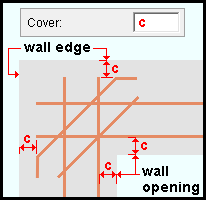
Note: If a corner bar extends into the cover, it will be bent to prevent infringement.
If ' Add opening ' is checked (
), the opening is modeled with multi-sided flat plate material , as well as the reinforcement.
If ' Add opening ' is not checked (
), only the reinforcement is modeled. No opening is shown.
Note: If you uncheck " Add opening " and also uncheck all of the " Add reinforcement " options, no part of the component will appear in the model that can be selected visually. In that case, you could still edit the Concrete Wall Opening component by selecting the wall or layout it was added to, or select the component in the model tree.
|
A Concrete Wall Opening component is automatically set to "
Graphical " whenever you make graphical changes to any of its materials. For example, when you Edit Material or apply the Extend Rebar Ends tool on one of its reinforcement bars. This stops the component from being changed during Process and Create Solids . Click here for more information.
Instead of allowing the component to be made "
Graphical ," you may wish to Explode Component .
------  Reinforcement settings ------
Reinforcement settings ------
Add vertical (or horizontal or corner) reinforcement: ![]() or
or ![]() .
.
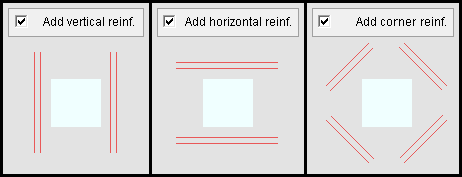
|
| In the examples above, the " Number of bars " is set to ' 2 '. |
If ' Add reinforcement ' is checked (
), reinforcement will be added around the specified edges of the opening.
If ' Add reinforcement ' is not checked (
), reinforcement will not be added.
Note: You can uncheck (
) all of the reinforcement settings; however, if you do that, no rebar will be modeled. If you also uncheck " Add opening ," no part of the component would appear in the model that could be selected visually. In that case, you could still edit the Concrete Wall Opening component by selecting the wall or layout it was added to, or select the component in the model tree.
concrete | model > component > | add component | top
| Rebar Settings |
------  Vertical / Horizontal / Corner rebar ------
Vertical / Horizontal / Corner rebar ------
( The following options apply to " ![]() Vertical " "
Vertical " " ![]() Horizontal" and "
Horizontal" and " ![]() Corner rebar ".)
Corner rebar ".)
Size: A size designation that has been entered to the Rebar Definitions Setup window under the " Active rebar standard ".
Specification: A615 or A706 or etc. This is an ASTM specification entered into the Rebar Specifications window.
The " Grade " and " Coating " options are limited to the grades and coating entered into the Rebar Specification window for the selected ASTM specification.
Grade: 60 or 40 or etc. This is the yield strength (grade) of the rebar.
The grade choices in this list box are limited to those entered in the Rebar Specification window for the " Specification " chosen for this rebar shape.
Coating: None or a Coating designation that is available in the " Standard " that you have selected.
The coating choices in this list box are limited to those entered in the Rebar Specification window for the " Specification " chosen for this rebar shape.
Select ' None ' if you do not want a coating. Since it is possible to create specifications that do not have coatings, it is possible that ' None ' may be your only option.
User configuration: If a coating is not available for selection, selecting a different " Specification " will make that coating available if the coating you want is in that other standard. If you don't want to change to a different " Specification ," you can open the Rebar Specifications window and add the coating you want to the specification that you currently have selected.
Number of bars: For each side or corner of the opening, this is the number of horizontal or vertical or corner bars on each layer. The number you enter must be greater than zero.
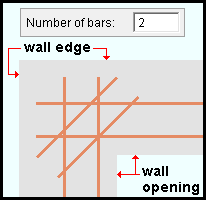
Distance between: The distance (in the primary dimension " Units " or other units ) between the horizontal or vertical or corner bars. This options applies only when the " Number of bars " is greater than one. Otherwise, this field will be disabled ( grayed out ).
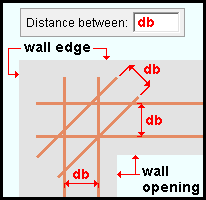
Rebar layers: The number of layers of horizontal or vertical or corner bars. The number you enter must be greater than zero and less than six. Each layer will have the ' Number of bars " that you specify on each side or corner.
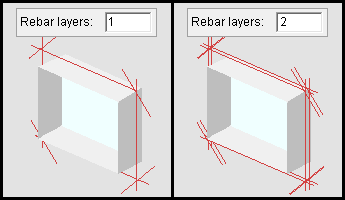
|
| In both of these examples, the " Number of bars " is set to ' 1 '. |
------  Vertical / Horizontal rebar ------
Vertical / Horizontal rebar ------
( The following option applies to " ![]() Vertical " "
Vertical " " ![]() Horizonta l" rebar.)
Horizonta l" rebar.)
Bar extension: The distance (in the primary dimension " Units " or other units ) from the nearest edge of the opening to the nearest end of the bar. This is a maximum, however; the bar will be modelled shorter if it would otherwise extend into the " Cover ."
------  Corner rebar ------
Corner rebar ------
Corner bar length: The length (in the primary dimension " Units " or other units ) of each corner bar. The bar will be modeled bent if it would otherwise extend into the " Cover ," but will remain the same length.







